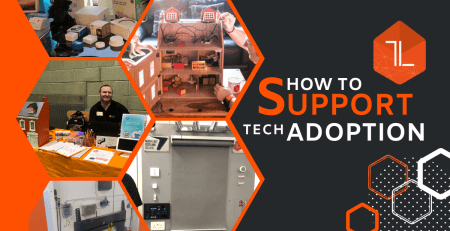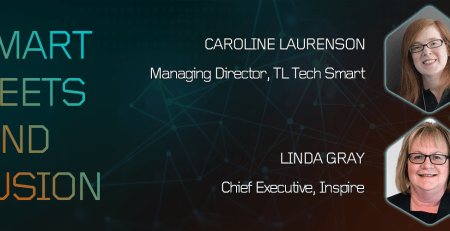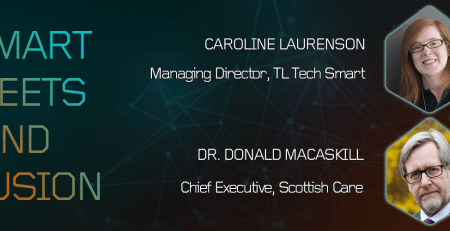Redefining the Role of the Smart Home
Estimated reading time: 10 minutes
When we think about smart homes we often immediately think of the latest gadgets and the tech giants driving negative behaviours of consumerism. The products and services available lack any sense of cohesion and can often seem to be missing real purpose other than entertainment and time saving convenience.
But what if the smart home could be transformed into a force for good, where our home can support us as we age and through any life situations, such as recovering from an accident or declining cognitive ability.
This article discusses the opportunity to redefine the role of the smart home, showing how it can offer support to enhance wellbeing and bring families closer. We believe very passionately that smart homes should be accessible to all regardless of age, technical ability, or finances.
More and more people are living alone, sometimes that is through choice and for others it is due to things that happen in their life, perhaps the breakdown of a relationship or, sadly, if their partner passed away.
Technology can help with so many aspects of life and assisted living, providing people with practical support, comfort, security, and connection to the outside world.
About Our Blog
We live in an ageing society. But what does that really mean?
In the next 20 years the balance of young and old will shift to the point where there will be one elderly person for every two people of working age. The challenge this presents is two-fold, a reduction in family members able to provide support and a smaller pool of professional carers.
TL Tech is a Smart Homes Solutions provider with a difference. We help people get the best out of smart home technologies and create unique home environments to meet their needs and budget. Our vision is to “create a home that cares for you as you age”.
Smart home technologies have the power to transform lives, especially for the vulnerable in our society. This blog series will be looking to showcase the opportunities, find out more about the people working in this field, and how we can create a world where “smart meets kind” ®.
Creating the Future of Smart Homes & Barriers to Realisation
Showcasing the “Value” in a Smart Home
To really make sure that we are ready for the future, development of new homes should consider internet connectivity. Our homes are now rated for energy efficiency, and people see the direct link between a well-insulated home for example and their energy bills. There is a similar analogy with connectivity in the home – a well-designed smart home can help with managing energy usage, ensure good air quality, detect issues such as leaks. All these things reduce your household bills and potentially could be used as risk indicators linked to your home insurance premiums.
At the moment, people aren’t clear on the benefits and they are not incentivised to adopt new technology. There is a need for regulators to get involved to improve the digital quality of both existing homes and new builds.
Perceptions of Technology
People have a perception that technology removes social connection, but there are so many supportive online communities that would not exist if it weren’t for technology. For someone on their own or dealing with a life change, it is hugely comforting to know that there are others going through something similar, or who can offer guidance and reassurance that things will get better. A great example of this is The Bunker UK on Facebook. Which was set up as a way for people with disabilities who are shielding to provide support and advice on how best to manage this difficult time.
There are also fears about how our data is used and who has access to it. This discussion becomes even more emotive when it comes to technology in the home, where the data often involves video footage and voice recordings. Most people have become accustomed to using computers and mobile phones and therefore don’t worry as much about the connection between what they do online being trackable and personal data that provides insight to their habits and preferences. Because smart homes and voice assistants are new, there is more suspicion around how they work and, quite rightly, people want reassurance that the technology has the right protections in place to make sure data is not misused.
Accessible Design, Addressing Inequalities & Education
Technology doesn’t work when it is imposed on people or becomes too rigid and standardised. Individuals have to be free to make their own choices about what works for them. But for many choice is a luxury that they can’t access.
We believe it is the responsibility of designers to incorporate accessibility as a primary consideration, rather than an afterthought. Given that housing is designed to last for decades, we need to make sure that future needs are addressed and as technology advances our home will be able to keep up. Certain things are now mandatory in homes when it comes to accessibility, like ensuring that the home can be accessed by wheelchair, without awkward steps and having washroom facilities that can also be accessed by wheelchair. Light switches must be positioned at a height where they can be reached from a seated position. Yes, a home can be adapted if needs change in the future, but this will almost certainly cause disruption and can be expensive.
We need to address the inequalities in our society and enable people to access digital services. This requires not only financial support to pay for home internet and electronic devices but also schemes that help to teach people how to use new technologies and make them more confident about trying new things.
There is another huge misconception that people who are older don’t like technology because it is too complex. It is usually the case that they haven’t had the right support to learn how to use technology and adapt it so that it works better for them, or sometimes that it’s merely the case that they need time to get used to it. That is where we focus our business and we have created content on our website and social media channels to help build people’s confidence. Unfortunately, a lot of the help guide content on smart homes is very technical or focuses on being entertaining and showcasing the latest gadgets. Also, quite often guides are focused on the American consumer and therefore don’t really help someone who is new to smart homes in the UK.
We would love to have a hands on mobile facility that we could take to events, groups, and individuals that would give them the opportunity to find out more about new technologies and how they might be able to utilise them to maintain their independence and wellbeing. There’s a great project over in Connecticut, America, called the Smart Home on Wheels, or SHOW for short. It makes a big difference for someone to see a system in real life to help them visualise how it would work in their own home before making the investment.
A Catalyst for Change
Technology has had a huge influence on our ability to be able to wait out the pandemic. We can work from home, shop from home, watch a movie, do a yoga class. For many it has opened our minds and hearts to what is possible.
At TL Tech we’d like to see this be a catalyst for change. When something like this happens, it can be really hard to see a way out. Our co-founder Caroline is a chemical engineer by background, bringing expertise in optimising a whole system and applying robust safety barriers. She believes that an engineering systems approach is needed to ensure solutions address all needs and that resources are focussed in the right areas.
Change will be Slow
Yes, there are learnings from our current situation, but unfortunately the underlying issues were there before. Inadequately resourced social care, zero hours contracts, high staff turnover because of poor pay (primarily because it is seen as women’s work) for social care providers, a society that does not value the older generation and sees them as a burden, etc. It is a rather depressing and complex range of societal issues and therefore changing this engrained culture will be difficult and slow. However, now the issues are much more visible, whereas before, people didn’t give them much thought. We need to make sure that the tragedy that has unfolded in our care homes and hidden in the homes of individuals is properly reviewed and improvements are implemented.
Technology is Only Part of the Solution
Technology will play an important part in how we prepare for the future and how we support people to be independent and maintain their health and wellbeing at home. By looking at the fundamental processes and procedures, streamlining these and incorporating technology to automate tasks where possible, or perform analytics on the data to spot and predict trends, we will be able to make real improvement in the outcomes for people.
A great example of this is a project funded by the CC2i initiative that will allow people to perform their own care assessments at home with remote support from occupation therapy staff. Traditionally the cost of delivering home visits is expensive and can require manual input of data to the care provider’s operations management systems. The forms and data are often not in a format that is readily able to be shared with others or combined with other data sources to enrich the understanding of a person’s care needs.
Beware of Data Overload
There is a growing cohort of tech companies offering sensor packages which passively monitor a person in the home. However, there’s a danger of data overload and collecting data which is unnecessary. There is a great saying “Just because you can doesn’t mean you should”. It’s important to know what data is meaningful, and most importantly how to present this so that it is appropriately actioned, i.e. it’s not about sharing the data in its raw format, but performing analytics on it to then share what the data means. This also has benefits when it comes to privacy and how comfortable we feel about having sensor data shared outside of the home. In many ways this data is a bit like the data from an industrial manufacturing process, where the engineers are using it to maintain safety and product quality. Not every part of the process is monitored and measured, by understanding the desired outcomes you focus on the key control parameters and monitoring indicators only. These key data points are managed hierarchically to make sure that the operators in the control room don’t get fatigued by it and are able to intervene at the right time. In our modern world data fatigue is a real phenomenon and the last thing we want is our smart homes adding to this.
Key Takeways
It’s exciting to take a look at what our homes might look like in the future. But we need to make sure that it is not tech for techs sake and that as technology advances that those who can benefit from it most are not left behind. We’ve discussed here the opportunity that exists and also some of the areas that require careful consideration if we are to realise the benefits of a home that cares for us as we age.
Nowhere do we show our individuality more than in our homes. It is a basic human need to create a place of shelter, the smart home is another layer in home design and how we interact with the space around us. How does your home make you feel? What would you like to see in the future of smart home technology?
You can hear more about TL Tech’s views on the smart home and its use in supporting care delivery in The Smart Life podcast episode recorded earlier in the year.
If you liked this post, check out our website for more technical advice on using voice assistants. You can also subscribe to our mailing list to be notified when we have new posts and support material available. You can also join our Facebook community group, which is a safe space to ask questions or share your own tips and advice. Just search for Smart Meets Kind or use this link and request to join.
We love to hear your stories of how you have been using smart home technologies and what tips that you might have discovered to share with others, so please do get in touch also on our social media channels.







Leave a Reply